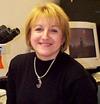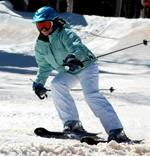Diseases & Conditions
Patient Story: Knee Ligament Injuries

Dana Gaddy, PhD, is a bone scientist who has been athletic and active her entire life. Formerly a competitive gymnast, Dana is a swimmer, runner, and snow skier. Dana's husband, Larry Suva, PhD, is also an orthopaedic researcher who shares her passion for skiing. They have attended a bone research / ski meeting in Snowmass, Colorado, annually since 1998.
"I ski mostly on intermediate and expert runs. However, my technique improved and in 2003 and 2004 I started skiing 'double-black' expert runs," Dana recalls. "On one of these runs, I made it to the bottom, but was tired and going too slow. When my left ski went into the deep powder and stuck, and the other ski made a turn, I heard my ACL pop."
Dana ruptured her left anterior cruciate ligament (ACL) and her medial collateral ligament (MCL), two of the four major ligaments that stabilize the knee. She had surgery at the University of Arkansas Medical Center to repair the ligaments, and endured six months of physical therapy before returning to the slopes. In September of 2004, Dana had a subsequent ACL repair surgery called autograft bone-patella-bone repair. She again rehabilitated and returned to competitive skiing six month later with no brace.
In April 2011, however, a ski race accident ruptured Dana's right ACL and MCL and tore her medial meniscus and patellar tendon. "An integral part of the ski-meeting is a NASTAR race competition," Dana explains. "I'm a strong competitor and won or placed several years in a row, and pushed to stay competitive."
During April's race, Dana was skiing at top speed when she fell. Her right ski stayed attached to her boot, and she experienced a high-impact trauma that caused significant damage to multiple components of her right knee. "I heard the pop, along with other noises at the time of the injury, and knew that this injury was worse than the first one."

All too familiar with ligament repair surgeries, Dana had ACL reconstruction on her right knee shortly after the April ski accident. Four months later, Dana elected to have an allograft patellar tendon repair. Initially, after her surgery, her knee was healing well. However, she developed laxity in her joint and the screw has become loose. Her right knee is increasingly unstable, and she wears a knee brace for all activities. Dana is concerned about developing posttraumatic arthritis in her knees.
"As the screw has continued to work its way out, the instability has gotten worse," she says. "As a result, my activity level decrease has led to a 15 pound weight gain over the last year. I cannot consider skiing, even with an external brace." Dana and her husband have aspirations to retire to Colorado to teach ski part time, and she is concerned that she will not be able to enjoy her favorite hobby.
Dana is scheduled for revision surgery on her right knee this April, immediately following the 2012 Snowmass ski meeting. She is planning to have an autograft bone-patellar tendon-bone repair, the same surgery that successfully repaired her left knee in 2004. Dana has high hopes for her forthcoming surgery. She is eager to return to her active lifestyle and regain the ability to live life fully.
Dana hopes to see more research into allograft versus autograft surgeries to repair knee ligament injuries. She would like to see research dollars directed toward comparative clinical research studies to help determine the most effective procedures for traumatic knee injuries and reduce complications.
Last Reviewed
October 2012
AAOS does not endorse any treatments, procedures, products, or physicians referenced herein. This information is provided as an educational service and is not intended to serve as medical advice. Anyone seeking specific orthopaedic advice or assistance should consult his or her orthopaedic surgeon, or locate one in your area through the AAOS Find an Orthopaedist program on this website.






